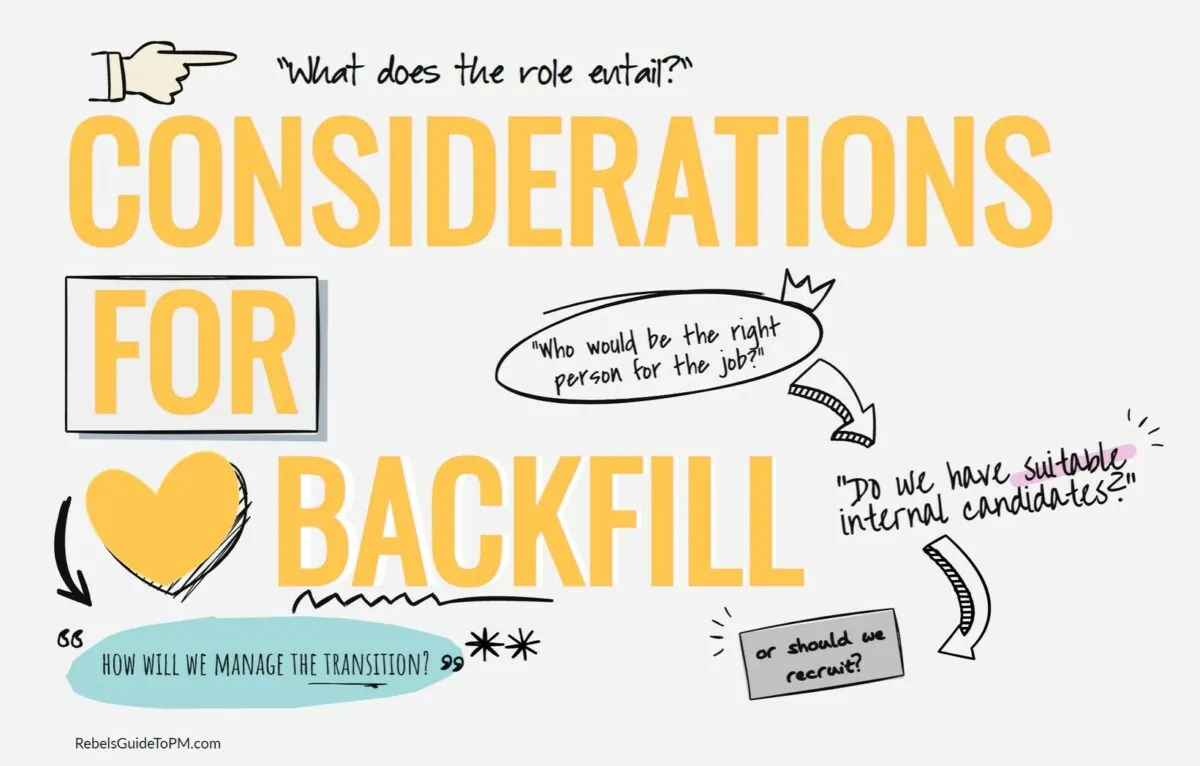5 Reasons to Backfill Roles
Why would you want to backfill a role? For one position I backfilled, we wanted a particular specialist role to come and work in a project delivery capacity for a year, so we had the right skills on the project team.
Backfilling means there is no gap in the team. You get an expert with the right skills to fill a vacant position temporarily.
Here are 5 reasons why you might want to backfill a position.
1. Short-term absence
For a short-term absence, you wouldn’t normally look at backfilling a position unless it was critical that someone was available in the role. Does anyone backfill you while you’re on vacation? Probably not – although you might write a handover email to a colleague in case there are any questions while you are away.
However, some roles have to be filled during absence, especially customer-facing roles. Backfilling can avoid costly disruption. For example, in a hospital, you might bring in additional clinical staff during short-term absence so that clinics don’t have to be cancelled.
When someone is on jury service, military leave, paternity leave and so on there might be cause to find someone to fill the gap. Filling the gap is harder for managerial positions in this case (in my opinion) as to be a good manager you need to know the team, but it might be possible for an internal candidate to step up temporarily.
In this case, you might need to backfill the role by finding a temporary member of staff, contractor or agency worker who can step in to take on the workload of the absent employee.
2. Long term absence
Long term absence could be caused by sickness or planned absence like maternity or shared parental leave.
You may or may not have notice that this is happening (yes for maternity, no for sickness) and you may be able to cope without the role being filled for a bit before the backfill need becomes urgent.
Filling a role like this will most likely go through the normal hiring process for your organization. You might have a range of potential candidates to interview and they’ll be with you for many months so it’s worth taking the time to write a good job description.
Ideally, you’ll have the time to work with the person leaving to carry out a handover. You can make contingency plans for what will happen when they are out of the business.
You might also find it helpful to use the opportunity to upskill another member of the team. Then they can move into a more senior role because they will have had several months of experience by the time the person comes back.
3. Secondment
Another type of long term absence is someone being seconded to a project team.
For example, the project team needs a particular set of skills. A call goes out to the staff with those skills and someone is chosen (or “volunteered”) or interviewed for the role. However, their day job still needs to be done. Their move to the project team creates a gap in their ‘home’ team, and that gap needs to be backfilled.
A project secondment could be six to nine months or longer.
In my experience – and you might have felt this too – people who are given a project-related secondment don’t always want to go back to their ‘home’ team. They’ve learned a lot, taking on additional responsibilities, experienced the highs and lows of project delivery and going back to their day job feels like a backwards step.
Secondments can be great for employee morale and career progression, although that does give the ‘home’ manager a bit of a headache as they’ve got to find a suitable candidate to replace them!
If that’s the case, you might consider what permanent opportunities you could find for them that would make use of their new skills.
4. Sabbaticals
A sabbatical is where someone leaves their role in the organization for a set period of time and their job is held open for them. In an academic setting, educators might go on sabbatical, which means they leave their teaching duties but spend time researching instead.
Sabbaticals are also benefits offered by some companies. I know a company that offers staff a 6-month break after a specific amount of service, and that’s a great perk. People use it for travelling.
I think this is the rarest reason why you’d want to backfill a role, but it’s a possibility that might come up in your career as a line manager.
Fortunately, sabbaticals are likely to be planned in conjunction with the employer, so you should have adequate notice for any recruitment necessary.
5. Leaving
Finally, you might need to backfill a role because an employee has left. People leave for lots of reasons, so your staffing gap could be because:
- They’ve quit to go and work somewhere else
- You’ve asked them to leave and their contract has been terminated
- They have chosen to retire
- There has been an organizational restructure and they have been moved to another area of the business or their role has been transferred to a third party and they’ve gone with it (in the UK this is TUPE).
In some of those cases you’ll have notice and the current employee should be able to provide some knowledge transfer and a handover.
For example, it’s normally pretty obvious when someone is retiring. I know past colleagues who have left the business to retire spent a lot of time talking about their plans – they weren’t shy about letting people know they were off!
Even in other cases, you might have some notice, so use that to get ready to fill the gap.
When someone leaves, you are likely to want to replace them with an equivalent full-time head. In this case, you’re backfilling the role but with a permanent hire – and that’s not really backfilling.
Backfilling in this situation would be to get a temp worker into the job quickly while you look for a permanent replacement.
If you’ve ever seen a colleague with ‘Acting’ in their job title then they are probably filling in while the empty post is being recruited for.
Get ready to backfill now
All of these reasons require a proactive approach so you are ready to move and fill a role on a temporary basis whenever you need to. If you do get an inkling that someone is likely to be out for any length of time, have a plan for what you will do.
Cross-training colleagues now will help you have a pool of people in the team to draw from should the need arise, although obviously you’ll sometimes need specialist skills hired in through external recruitment.
Remember, the worst outcome is that you dump the workload of a key employee on someone else in the team and that leads to burnout and low morale. Backfilling is the solution to that: no on should be expected to do two people’s jobs.



